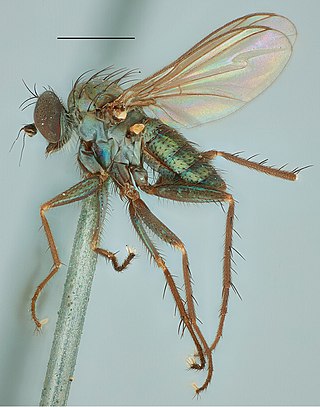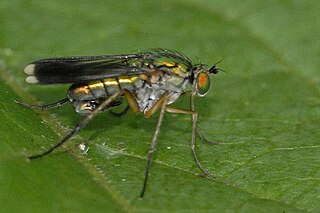
Argyra is a genus of flies in the family Dolichopodidae. The name "Argyra" comes from the Greek word for "silver", referring to the silver pruinescence found on the males of many of the species.
Acropsilus is a genus of flies in the family Dolichopodidae. It is unplaced in the family, having been placed variously in subfamilies such as Sympycninae or Peloropeodinae. It is superficially similar to the Medeterinae.

Asyndetus is a genus of flies in the family Dolichopodidae. There are more than 100 species described for the genus, distributed worldwide.

Diaphorus is a genus of flies in the family Dolichopodidae. Lyroneurus was formerly considered a subgenus, but is now either treated as a synonym of Chrysotus or treated as a distinct genus.
Diostracus is a genus of flies in the family Dolichopodidae. It includes about 100 species described from the Nearctic, Palaearctic and Oriental realms. In 2013, it was expanded to include the former genera Lagodechia and Sphyrotarsus as subgenera.
Micromorphus is a genus of flies in the family Dolichopodidae.

Rhaphium is a genus of flies in the family Dolichopodidae. It is the largest genus within the subfamily Rhaphiinae, with over 200 species currently known.

Sybistroma is a genus of flies in the family Dolichopodidae. It includes over 50 species, described mainly from the Palaearctic and Oriental realms. A single species is known from the Afrotropical realm. Until 2005, the genus was thought to be restricted to the Mediterranean in distribution, with five known species. It was recently expanded to include the former genera Hypophyllus, Ludovicius and Nodicornis, as well as some species of Hercostomus.

Syntormon is a genus of flies in the family Dolichopodidae. It includes about 110 species worldwide, more than 50 of which were described from the Palaearctic realm.

Tachytrechus is a genus of long-legged flies in the family Dolichopodidae.

Teuchophorus is a genus of long-legged flies in the family Dolichopodidae. There are more than 130 described species in Teuchophorus.

Thinophilus is a genus of flies in the family Dolichopodidae. It includes about 146 described species distributed worldwide. Most species of the genus are found in coastal habitats, while a few species are found in freshwater habitats.

Dolichopodinae is a subfamily of flies in the family Dolichopodidae.

Peloropeodinae is a subfamily of flies in the family Dolichopodidae. In some classifications, the genera of the subfamily are included in Sympycninae. According to a molecular phylogenetic analysis of the family Dolichopodidae by Germann et al. (2011), the subfamily is polyphyletic.

Poecilobothrus is a genus of flies in the family Dolichopodidae.

Sympycninae is a subfamily of flies in the family Dolichopodidae. In some classifications, this subfamily includes the genera of the subfamilies Peloropeodinae and Xanthochlorinae.













